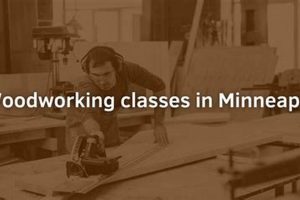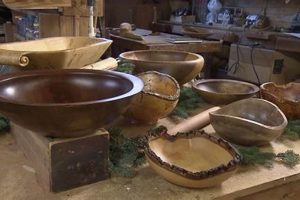Instructional sessions focused on the craft of shaping wood, available in the city of Eugene, Oregon, provide opportunities for individuals to learn and develop skills in various woodworking techniques. These educational programs range from introductory courses for beginners to advanced workshops for experienced woodworkers. Course content typically covers topics such as wood selection, tool usage and maintenance, joinery methods, and finishing techniques.
Participation in such programs fosters creativity, problem-solving abilities, and fine motor skill development. Historically, woodworking has been a fundamental craft with practical and artistic applications. Engaging in it connects individuals to a rich tradition while offering practical skills applicable to furniture making, construction, and artistic expression. These classes offer an avenue for personal enrichment and potential career development.
The following sections will detail specific types of instructional programs offered, resources available to participants, and considerations for selecting the most appropriate educational opportunity based on individual skill levels and learning objectives. Information regarding instructors and studio facilities will also be provided, further assisting in the selection process.
Guidance for Selecting Woodworking Education in Eugene
Choosing the appropriate woodworking instruction requires careful consideration of several factors. The following guidance provides insight into making an informed decision regarding educational opportunities in the Eugene area.
Tip 1: Assess Skill Level: Accurately gauge existing woodworking experience. Beginner classes are tailored to individuals with no prior knowledge, while intermediate and advanced courses require a foundation of skills. Selecting a class that aligns with current abilities ensures a productive learning experience.
Tip 2: Define Learning Objectives: Determine specific woodworking skills desired. Classes may specialize in furniture making, carving, turning, or other specific areas. Identifying goals upfront allows for targeted course selection.
Tip 3: Research Instructor Qualifications: Investigate the instructor’s experience and credentials. A qualified instructor possesses both woodworking expertise and effective teaching abilities. Reviewing portfolios or seeking testimonials can provide valuable insight.
Tip 4: Evaluate Studio Facilities: Inspect the woodworking studio environment. Ensure adequate workspace, equipment availability, and safety measures are in place. A well-equipped and organized studio promotes effective learning.
Tip 5: Consider Class Size: Smaller class sizes often allow for more individualized attention from the instructor. Larger classes may offer a broader range of perspectives and collaborative opportunities. The optimal class size depends on individual learning preferences.
Tip 6: Inquire About Materials and Tools: Clarify whether the class provides necessary materials and tools or if participants are responsible for supplying them. Understanding material and tool requirements helps budget accordingly and avoid unexpected costs.
Tip 7: Review Course Curriculum: Scrutinize the syllabus or course outline. Ensure the curriculum aligns with learning objectives and covers the desired woodworking techniques. A comprehensive curriculum maximizes the value of the instruction.
Following these guidelines facilitates a more informed decision when selecting woodworking instruction. This leads to a more rewarding and productive learning experience.
The subsequent section will explore the long-term benefits associated with engaging in woodworking as a hobby or profession.
1. Skill Development
Woodworking education offered in Eugene is intrinsically linked to the acquisition and refinement of woodworking skills. These instructional programs function as a structured pathway for individuals to develop proficiency in various techniques, ranging from foundational skills such as safe tool operation and basic joinery to more advanced practices including furniture design and intricate carving. The curriculum within these classes directly influences the type and level of skills participants acquire. For instance, a beginner’s course might focus on mastering the use of hand tools and constructing simple projects, while an advanced workshop could delve into complex joinery techniques and the creation of elaborate furniture pieces.
The development of specific skills is a primary motivation for enrolling in woodworking education. Effective skill development translates directly into tangible outcomes. Someone completing a furniture-making course, for example, can then construct custom furniture pieces for their home or even pursue furniture making as a profession. Furthermore, the skills learned extend beyond the specific craft itself. Problem-solving, spatial reasoning, and attention to detail, all cultivated through woodworking, are transferable to other areas of life and work. A well-designed curriculum ensures that participants acquire not only technical expertise but also these valuable cognitive skills.
Ultimately, the effectiveness of woodworking education in Eugene hinges on its ability to foster meaningful skill development. This requires experienced instructors, well-equipped facilities, and a curriculum tailored to meet the diverse needs and skill levels of the participants. Successfully connecting individuals with the appropriate learning opportunities enables them to achieve their woodworking goals, whether for personal enrichment or professional advancement. Challenges remain in ensuring accessibility and affordability, but the potential for skill development makes these educational programs a valuable resource for the community.
2. Material Costs
Material costs represent a significant factor in the accessibility and feasibility of engaging in woodworking education within Eugene, Oregon. These costs directly impact participant affordability and the overall scope of potential projects.
- Wood Species and Pricing
The selection of wood species directly correlates with material costs. Exotic hardwoods or specialty lumber command higher prices than readily available softwoods like pine or fir. A class focusing on furniture construction using premium hardwoods will invariably have higher material fees compared to a class utilizing common lumber for smaller projects. This difference influences participant choice and the perceived value of the educational experience.
- Consumable Supplies
Beyond the cost of lumber, woodworking classes necessitate the use of various consumable supplies such as adhesives, finishes, sandpaper, and fasteners. The quality and quantity of these materials also contribute to the overall expense. Classes providing high-quality, specialized finishes will likely incur higher material charges than those employing basic, readily available alternatives.
- Tooling and Equipment Access
Some classes require participants to provide their own hand tools or accessories, adding to the initial investment. Alternatively, classes that offer access to a fully equipped shop often incorporate the cost of tool maintenance and replacement into the material fees. This consideration is crucial for individuals on a budget, as purchasing a full set of woodworking tools can be a substantial expense.
- Project Complexity and Scale
The complexity and scale of the projects undertaken in a woodworking class directly affect the amount of materials required and consequently, the associated costs. Larger, more intricate projects necessitate greater quantities of lumber, hardware, and finishing supplies, resulting in increased material expenses. Smaller, simpler projects, conversely, offer a more budget-friendly option for individuals seeking to learn the fundamentals of woodworking without a significant financial commitment.
The interplay between these facets of material costs shapes the landscape of woodworking education in Eugene. Understanding these cost factors enables prospective participants to make informed decisions about which classes align with their budget and learning objectives, thereby fostering greater accessibility and participation in the craft.
3. Instructor Expertise
Instructor expertise represents a critical determinant of the quality and effectiveness of woodworking instructional programs available in Eugene, Oregon. A qualified instructor’s knowledge, practical skills, and pedagogical abilities directly influence the learning outcomes for participants. Their proficiency in woodworking techniques, tool usage, and project management serves as the foundation for delivering comprehensive and accurate instruction. For instance, an instructor with extensive experience in furniture making can effectively guide students through complex joinery methods, while an instructor specializing in wood carving can impart intricate carving techniques and artistic principles. The depth and breadth of the instructor’s expertise directly correlate with the quality of the learning experience.
The impact of instructor expertise extends beyond technical skill. Effective instructors possess the ability to communicate complex concepts clearly, adapt their teaching style to accommodate diverse learning needs, and provide constructive feedback. Real-world examples of the impact of instructor expertise are evident in the success stories of woodworking students who have gone on to create successful businesses or pursue advanced woodworking projects. An instructor’s guidance and mentorship can inspire confidence and foster a passion for woodworking, contributing to long-term skill development and engagement. Furthermore, experienced instructors often possess a network of contacts within the woodworking community, providing students with valuable connections and opportunities for collaboration and professional growth. Practical significance lies in recognizing the value of seeking out instructional programs led by experienced and qualified instructors, as this significantly increases the likelihood of achieving desired learning outcomes.
In summary, instructor expertise is an indispensable component of successful woodworking educational programs. A knowledgeable and skilled instructor not only imparts technical proficiency but also fosters critical thinking, problem-solving skills, and a deep appreciation for the craft. While challenges exist in ensuring access to highly qualified instructors for all participants, the understanding of the crucial role of expertise underscores the importance of carefully evaluating instructor credentials and experience when selecting instructional opportunities. The future of woodworking education in Eugene hinges on maintaining a commitment to providing participants with access to instructors who possess the knowledge, skills, and passion necessary to inspire the next generation of woodworkers.
4. Studio Access
Studio access is a pivotal component of woodworking educational programs in Eugene, significantly impacting the learning experience and skill development of participants. The availability of a well-equipped and organized studio directly influences the scope and complexity of projects that can be undertaken, thus determining the range of techniques that can be effectively taught and learned. For instance, a studio with a lathe enables classes on wood turning, while a space lacking a jointer and planer limits instruction to pre-dimensioned lumber and restricts the teaching of crucial milling techniques. Therefore, the equipment and layout of a woodworking studio serve as a primary determinant of the curriculum’s practical application.
The quality of studio access extends beyond the mere presence of equipment. The availability of adequate workspace, proper ventilation, and effective dust collection systems contributes significantly to participant safety and comfort. A poorly ventilated studio can expose participants to harmful wood dust, while insufficient workspace can hinder project progress and increase the risk of accidents. Consider a scenario where a class is tasked with constructing a large table. Limited workspace forces participants to work in cramped conditions, potentially compromising the quality of their work and increasing the likelihood of injuries. Furthermore, the accessibility of tools and machinery is a crucial factor. A studio with an efficient organizational system allows participants to easily locate and utilize the necessary equipment, maximizing productive learning time.
In conclusion, studio access is not merely a supplementary feature of woodworking educational programs in Eugene, but rather an integral element that fundamentally shapes the learning environment and skill acquisition process. Challenges in securing and maintaining well-equipped studios can limit the accessibility and quality of woodworking education. Recognizing the practical significance of studio access underscores the need for ongoing investment in woodworking facilities and infrastructure to ensure that participants have access to the resources necessary to develop their skills and pursue their woodworking aspirations. The sustained growth and vitality of the woodworking community in Eugene depends, in part, on prioritizing and improving studio access within educational programs.
5. Project Variety
Project variety, within the context of woodworking classes in Eugene, directly impacts participant engagement and skill development. A limited range of projects restricts the breadth of skills acquired, potentially leading to decreased interest and hindering the application of knowledge to diverse woodworking scenarios. Conversely, a curriculum offering a wide array of project types allows individuals to explore different techniques, materials, and design principles. For example, a class incorporating projects such as box making, small furniture construction, and carving provides a more comprehensive learning experience than one focused solely on a single project type. This diversity allows participants to discover their strengths and preferences, fostering a deeper connection to the craft. The absence of project variety can result in a narrow skillset, limiting the participant’s ability to adapt and innovate in future woodworking endeavors. The practical significance of understanding this lies in the selection of classes that offer a balanced and diverse curriculum, ensuring a more enriching and valuable learning experience.
The availability of diverse projects also influences the perceived value of woodworking classes in Eugene. Participants are more likely to invest time and resources in programs that offer the opportunity to create a range of functional and aesthetically pleasing items. The tangible outcome of completing various projects provides a sense of accomplishment and motivates continued learning. Consider a class that allows participants to choose from a selection of projects, such as cutting boards, small tables, or wooden toys. This flexibility empowers individuals to pursue their specific interests and develop skills relevant to their personal goals. Furthermore, project variety facilitates a more collaborative learning environment, as participants can share ideas and techniques related to different project types. This exchange of knowledge enhances the overall learning experience and fosters a sense of community among woodworkers.
In conclusion, project variety constitutes a vital component of effective woodworking classes in Eugene. A diverse curriculum expands skillsets, enhances engagement, and increases the overall value of the educational experience. Challenges may arise in balancing project variety with the constraints of time and resources, but the benefits of offering a wide range of options outweigh the logistical complexities. Recognizing the importance of project variety empowers prospective participants to make informed decisions about class selection, leading to a more fulfilling and productive learning journey. The long-term sustainability of woodworking education in Eugene depends, in part, on prioritizing and fostering project variety within instructional programs.
6. Scheduling Options
The availability of diverse scheduling options directly impacts accessibility to woodworking educational opportunities in Eugene. The specific times, days, and durations of courses serve as practical constraints for prospective participants. Individuals with full-time employment, family responsibilities, or other time commitments require flexible scheduling to accommodate their participation. A limited range of class schedules, such as only weekday morning sessions, effectively excludes a significant portion of the population. The absence of weekend or evening classes, for example, restricts access for working professionals. Therefore, scheduling options function as a crucial gateway, determining who can realistically engage with woodworking instruction.
The type of scheduling offered influences the depth of knowledge that can be acquired. Intensive workshops spanning multiple consecutive days allow for concentrated learning and project completion within a shorter timeframe. Conversely, courses spread over several weeks or months provide opportunities for gradual skill development and project refinement. Consider a scenario where a participant is interested in learning furniture making. An intensive week-long workshop might focus on constructing a specific piece, while a semester-long course would allow for exploration of different design principles, joinery techniques, and finishing methods. The practical application lies in selecting scheduling options that align with individual learning preferences and time constraints, optimizing the effectiveness of the educational experience.
In conclusion, scheduling options constitute a fundamental aspect of woodworking educational programs in Eugene. A diverse range of schedules increases accessibility and caters to the varied needs of the community. Challenges in accommodating diverse schedules require careful consideration of class timing, duration, and frequency. Understanding the connection between scheduling and accessibility empowers prospective participants to make informed choices, ensuring greater participation in woodworking education. The sustained growth of woodworking as a craft and hobby in Eugene is contingent, in part, on addressing the scheduling needs of the community.
Frequently Asked Questions
The following addresses common inquiries regarding instructional programs focused on woodworking within the Eugene, Oregon area. Information is presented to clarify aspects of these educational opportunities.
Question 1: What types of woodworking courses are available in Eugene?
Educational offerings encompass a range of disciplines, including furniture making, wood turning, carving, and basic carpentry. Introductory courses are typically available for beginners, with more advanced workshops geared towards experienced woodworkers.
Question 2: What is the typical cost associated with woodworking instruction?
Course fees vary considerably depending on the length, complexity, and materials provided. Beginner courses tend to be less expensive, while specialized workshops or programs requiring significant material investment may incur higher costs.
Question 3: Are tools and materials provided, or are participants expected to supply their own?
The provision of tools and materials differs between programs. Some classes include all necessary supplies in the course fee, while others require participants to bring their own tools or purchase materials separately. Clarification regarding tool and material requirements is crucial prior to enrollment.
Question 4: What qualifications do woodworking instructors typically possess?
Instructor backgrounds vary but typically include formal training in woodworking, professional experience as woodworkers or craftspeople, and/or prior teaching experience. Reputable programs will highlight instructor qualifications and expertise.
Question 5: What is the typical class size for woodworking courses?
Class sizes range depending on the program and the type of instruction offered. Smaller class sizes generally allow for more individualized attention, while larger classes may facilitate collaborative learning opportunities.
Question 6: Are there any safety precautions or requirements for participating in woodworking activities?
Safety is paramount in any woodworking environment. Participants are expected to adhere to all safety guidelines provided by the instructor, including the use of personal protective equipment such as safety glasses and hearing protection. Completion of a safety orientation may be required prior to engaging in woodworking activities.
This information provides a preliminary understanding of woodworking instruction available in Eugene. Further research and direct communication with course providers is recommended to address specific inquiries.
The subsequent section explores resources available to support and enhance woodworking endeavors within the Eugene community.
Conclusion
The preceding discussion explored various facets of woodworking instructional programs within the Eugene, Oregon area. Key considerations include instructor expertise, studio access, project variety, scheduling options, and material costs. These factors directly influence the accessibility, quality, and overall value of woodworking education. Skill development remains a primary objective, encompassing techniques from basic tool usage to advanced joinery and furniture design.
Effective engagement with woodworking requires careful assessment of individual goals, skill levels, and resource availability. Selecting appropriate “woodworking classes eugene” provides opportunities for personal enrichment, skill enhancement, and potential career development. The continued growth and vibrancy of the woodworking community depends on accessible and high-quality educational resources.







